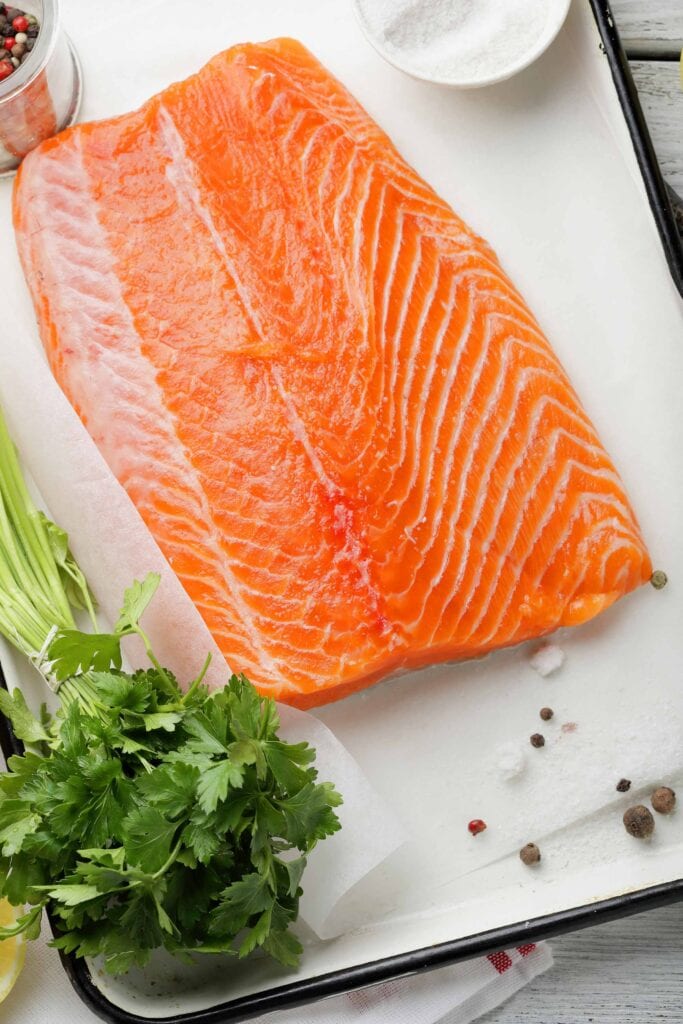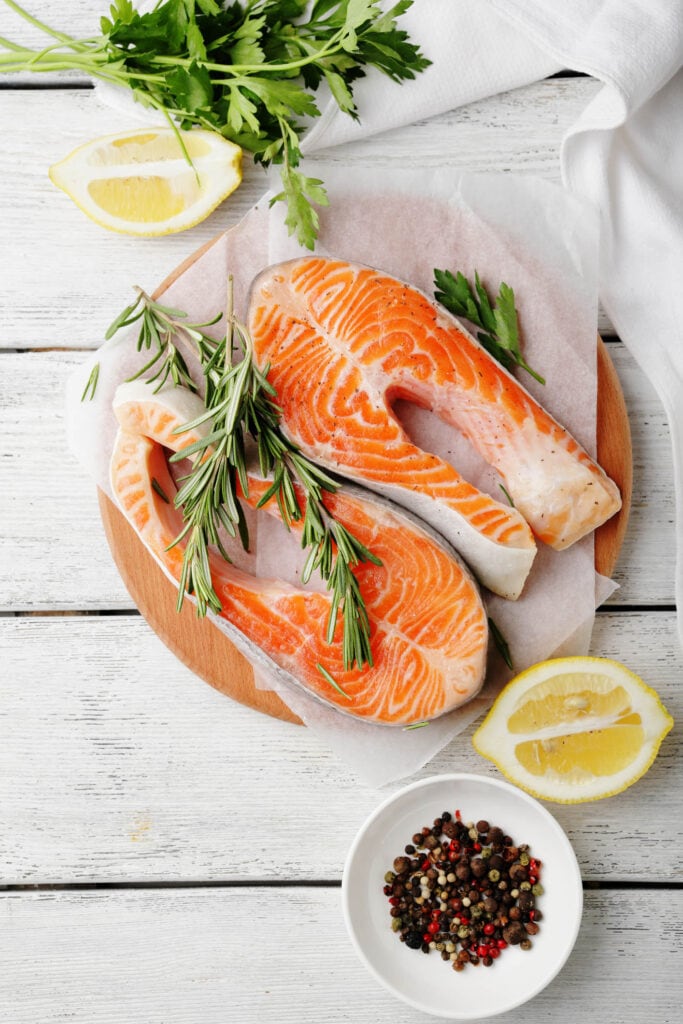Do you want to know what the main differences are between trout and salmon? This helpful guide goes into that, plus it has cooking tips, wine and food pairings, and what to look for when you’re shopping for fish.
Trout and salmon are two of the most popular types of fish. While salmon often steals the spotlight, trout is a delicious fish in its own right. But does trout taste like salmon? How different are they really?
In this article, we’ll compare trout vs. salmon on factors like:
- Flavor and texture
- Varieties and color
- Fat content
- Cooking methods
- Nutrition
- Cost
- Uses in recipes
We’ll help you understand what makes each fish unique so you can choose the best one for your dish or recipe. Read on to find out if trout and salmon can be used instead of each other or if there are too many differences between them to do so.
Trout vs Salmon Flavor
While trout and salmon are both freshwater fish in the same scientific family there are some key differences when it comes to their taste
-
Trout – Trout has a mild, slightly earthy flavor. The taste is often described as clean with a delicate flavor.
-
Salmon – Salmon has a stronger, more pronounced flavor than trout. It has a richer and deeper taste that can sometimes be almost buttery.
So salmon definitely has the bolder, richer flavor while trout is more delicate and subtle in taste. But the flavor differences depend on a few other factors too.
Color Varieties
Salmon and trout come in different colors, and this changes how they taste:
-
Chinook salmon – Also known as king salmon, it has a high fat content and silky orange-red flesh with the richest flavor.
-
Coho salmon – Leaner with a slightly milder flavor and medium red flesh. Still stronger tasting than trout.
-
Sockeye salmon – Deeper red flesh with a robust flavor balanced by moderate fat content.
-
Steelhead trout – Pink to deep red flesh with a delicate flavor. Considered one of the most salmon-like trout.
-
Rainbow trout – Pale pink flesh with a delicate trout flavor. High in healthy fats.
-
Brook trout – Light pink or orange flesh with very subtle flavor. Low in fat with a delicate taste.
So in general, the paler the flesh, the more mild the flavor, no matter if it’s trout or salmon. But even lean trout is more delicate than fattier salmon.
Texture Differences
Texture is another major difference between the two types of fish:
-
Trout – Fine flakes with a smooth, tender texture. Easy to break apart with a fork.
-
Salmon – Larger, meatier flakes with firm and dense texture. More resistant to flaking apart.
Trout is more moist and tender overall, while salmon is drier with a dense, supple texture. These texture differences affect their cooking methods and uses.
Fat Content
The amount of fat influences flavor and texture:
-
Trout – A lean fish with less than 5g total fat per 3 ounce serving. Low in fat compared to salmon.
-
Salmon – Considered a fatty fish with over 10g of fat per 3 ounce serving. Has over twice the fat content of trout.
The higher fat content contributes to salmon’s richer flavor and firmer texture when cooked. Trout has a more delicate flavor and tender texture due to its leanness.
Cooking Methods
The differences in texture and fat content mean trout and salmon cook up slightly differently:
-
Trout – Cooks faster with moisture retained. Best prepared using dry methods like baking, broiling, grilling or pan frying.
-
Salmon – Takes longer to cook through while keeping interior moist. Excellent steamed, poached or roasted.
Trout flakes easily when cooked, so be careful not to overcook. Fattier salmon holds up better to longer cooking times. Adjust recipes accordingly based on which fish you use.
Nutrition Profile
While quite similar in nutrients, here are some of the differences:
-
Protein – Both excellent sources, with salmon containing slightly more.
-
Fat – As noted, salmon much higher in total fat and omega-3s.
-
Vitamin D – Salmon contains nearly double the vitamin D of trout.
-
Vitamin B12 – Excellent amounts in both fish. Trout has slightly more B12.
-
Selenium – Higher in trout than salmon.
Both are considered superfoods packed with protein, healthy fats, and important vitamins and minerals. Salmon wins for omega-3 content, but trout contains more selenium.
Cost Comparison
You may also find differences in cost at the seafood counter:
-
Trout – Typically costs $4 to $8 per pound. Relatively affordable, especially for whole dressed trout.
-
Salmon – Runs from $8 to $13 per pound, sometimes more for wild-caught varieties like king salmon.
Farmed trout is widely available year-round, keeping costs low. More seasonal availability and high demand increases prices for salmon.
Uses in Recipes
Their similar flaky texture means trout and salmon can often be swapped in recipes, but keep these tips in mind:
-
For delicate dishes, opt for mild trout fillets over salmon to avoid overpowering other flavors.
-
In strongly flavored dishes with bold ingredients, choose salmon for its richness.
-
Adjust cook times and temperature as needed based on fat content and density.
-
Salmon’s firmer texture makes it ideal for grilling, broiling, and pan-searing or crusting.
-
Delicate trout works better for poaching, steaming, baking, or light pan frying with less time to flake easily.
-
For smoking, brining, or canning, salmon’s fat content gives it an advantage over lean trout.
The Bottom Line
While closely related, trout and salmon have distinct differences that affect their flavor, texture, cooking methods and uses. Understanding the key contrasts helps decide which fish works best for different recipes and preparation styles.
In general, lean trout has a subtler, more delicate flavor that lends itself well to quick, moist cooking methods. Fattier salmon has a rich, full flavor that holds up to intense heat while staying moist. While they can sometimes be used interchangeably, each fish shines best in recipes tailored specifically to its qualities.
The next time you’re debating between trout vs. salmon, consider what you’ll be preparing to determine which is the better fit. Both are amazing fish, so you can’t really go wrong with either healthy seafood choice!

Tips for cooking with trout
Trout is a seafood that’s easy to prepare for quick family dinners or healthy lunches. It’s delicate though, so use these cooking tips before you get started:
- Don’t cook the fish right away? Put it in the fridge for up to two days.
- Keep the seasonings simple. To make the trout shine, all you need is butter, lemon juice, garlic, salt, pepper, or fresh parsley.
- A light coating of flour on trout before cooking it in oil also makes it taste great.
- You can bake, pan sear, braise, or grill both the filet and the whole fish.

Most fish recipes pair particularly well with crisp white wines, and trout is no exception:
- It goes great with a glass of Sauvignon Blanc or Riesling because the flavors are light and mild.
Tips for cooking with salmon
Though salmon can be cooked in almost any way you can think of, these tips will help you if this is your first time cooking salmon:
- You can bake, grill, poach, slow roast, smoke, or even use the sous vide or Instant Pot to cook salmon.
- Cook it with or without the skin on. The skin, once crispy, is so delicious!.
- Use simple spices, like butter, lemon, or dill, to cook the salmon. You can leave it as is or add lemon butter sauce on top to make it taste even better.
- Or, try out one of these 15 sauces for salmon.
- What does Bon Appetit say? The salmon is done when it flakes easily when you poke it with your finger?

Full-bodied wines are some of my favorites to pair with rich, tender salmon, such as:
- Sauv Blanc and Chardonnay taste fresh and clean with salmon.
- With salmon, you don’t have to stick to the “white wine only” rule. A light Pinot Noir or a young Beaujolais with its acidity and earthy notes will also go well with the fish.
- Read the whole post to find out which wines go best with salmon.
Difference between Salmon and Trout Video June 2022 (Updated)
FAQ
Is trout very fishy tasting?
Do you cook trout like salmon?
Is trout cheaper than salmon?
Is trout basically salmon?
